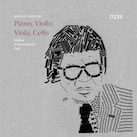

Nieuw Amsterdams Peil: Morton Feldman: Piano, Violin, Viola, Cello
TRPTK
A different kind of skill-set is called upon when musicians play a work by Morton Feldman (1926-1987). In place of high-velocity razzle-dazzle, he asks the performer to sustain focused concentration in compositions that last up to five (Crippled Symmetry) and even six hours (the Second String Quartet). Development unfolds glacially at an unchanging tempo and volume levels are pitched at a hush as the interpreter progresses through the material. While the activity level in certain classical minimalism pieces might be frenetic by comparison (think Philip Glass's early work), Feldman's engenders a kindred effect when full surrender to the music induces temporal suspension and cultivates a state of meditative calm in the listener.
Known simply as Piano, Violin, Viola, Cello, the piano quartet performed by Nieuw Amsterdams Peil (NAP) was completed by Feldman on May 28, 1987 and is, in fact, his final work. Nearly eighty minutes long in this iteration, the work is performed by NAP members Emma Breedveld (violin), Helen Hulst (violin), Mick Stirling (cello), and Gerad Bouwhuis (piano) and was recorded live at Groningen's Lutheran Church on November 3rd, 2023 as part of the Soundsofmusic festival. Formed by Hulst and Bouwhuis in 2005, NAP is a Netherlands-based new music collective that performs works by Louis Andriessen, Martijn Padding, Guus Janssen, and others; its reach extends, however, beyond Holland to figures such as Claude Vivier, Francis Poulenc, Dmitri Shostakovich, and John Cage.
That Feldman was influenced in the 1950s by Abstract Expressionist painters than by other composers comes as no surprise when, for this listener at least, images of Mark Rothko paintings emerge as Piano, Violin, Viola, Cello plays; nothing feels more natural in this instance than drawing a parallel between Rothko's absorbing fields of colour and Feldman's slowly shifting slabs of sound. Contrasting timbres, chord and note changes, and changing instrument combinations emerge during the work's unfolding, with the players generally hewing to an even dynamic level and a quiet volume. Despite its large temporal scale, the music's understated character lends it an inviting intimacy, and engagement never falters when the moment-by-moment directions the music takes are unpredictable. While the path it follows might be impossible to predict, it never feels random. Even if it seems as if the music is meandering, the path it pursues is carefully delineated by the score.
The work's haunting character asserts itself from the outset when the strings' short, reedy phrases are punctuated by reverberant piano chords and texture and atmosphere are emphasized over melody. That arrangement persists throughout but, as stated, unpredictably. During one passage, the piano and strings engage in seeming call-and-response; in another, the keyboard drops out and the strings deliver a multi-note figure alone. Despite incessant mutation, the work assumes the character of a sound sculpture, something one could as easily imagine experiencing as a gallery installation as concert hall piece. In a work of such character, a sudden, subtle change in presentation has a seismic impact. At the one-hour mark, for instance, a plucked bass note feels like a mini-detonation when it happens, and when a similar gesture occurs eleven and then seventeen minutes later it resonates as strongly. Occasionally, a more intense attack by the players increases tension, after which the even-keeled dynamic level reverts to the one generally defining the work.
As it's a recording of a live performance, an ambient noise occasionally surfaces, but there's also, thankfully, nothing to indicate the audience's presence. The eighty-minute duration of Piano, Violin, Viola, Cello makes it a palatable entry-point for anyone coming to Feldman's music for the first time; it also helps prepare the listener interested in scaling the monumental Crippled Symmetry and Second String Quartet. It hardly needs be said that a different set of listening expectations needs to be brought to a Feldman work than one by, say, Mozart or Debussy. With that adjustment made, a representative piece such as the piano quartet becomes a wholly inviting proposition.January 2025